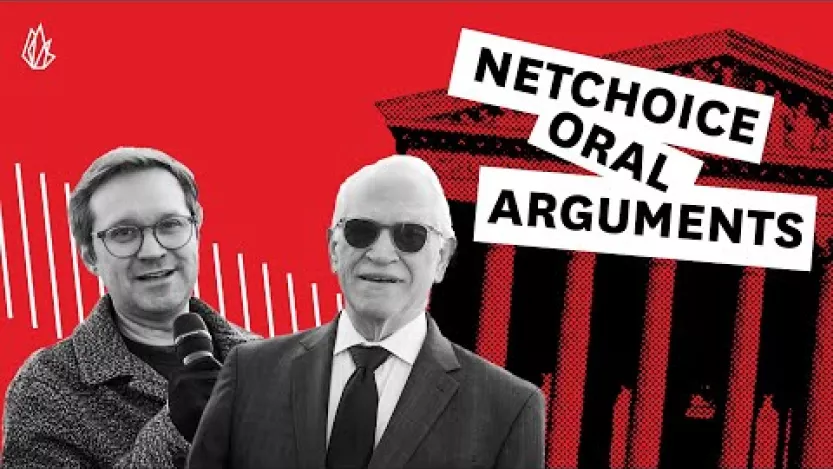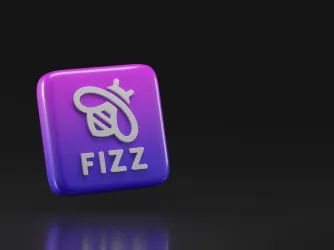Table of Contents
The 8 First Amendment cases the Supreme Court will decide this term

Shutterstock.com
UPDATED (July 1, 2024): As the Supreme Court rules on these cases, we will update this article accordingly.
The 2023-2024 Supreme Court term will be remembered as one that redefined the rules by which Americans interact online. It features eight cases that will have far-reaching implications for the ways we interact online, both with elected officials and with one another, and for how the government interacts with online platforms. The Court will also decide a case about the more general issue of governments pressuring private groups for political reasons.
Below are the First Amendment Supreme Court cases FIRE has been monitoring for how they will affect Americans’ fundamental right to free expression, what you need to know about them, and why they matter.
Decided Cases
Do laws that regulate social media content moderation violate the First Amendment?
Moody v. NetChoice and NetChoice v. Paxton (Decided July 1, 2024)
What you need to know
This question is also the subject of two cases, each involving social media regulations: one in Florida, the other in Texas.
The Florida law, Senate Bill 7072, was enacted in May 2021 to address allegations that social media companies were moderating content based on its particular political or ideological side. The law prohibits this type of “viewpoint discrimination” and requires social media sites to provide both notice and a “thorough rationale” to users any time their content is removed, hidden, or otherwise restricted from other users’ view.

NetChoice, a group representing social media platforms challenged and the district court blocked the law, finding that it likely violates the First Amendment by controlling the editorial and content moderation decisions of a private platform. The Eleventh Circuit agreed, characterizing the restrictions as overbroad and “an instance of burning the house to roast a pig.”
Meanwhile, in September 2021, Texas passed House Bill 20. The law applies to websites with 50 million or more monthly active users and prohibits these websites from moderating content based on the viewpoint it expresses. It also requires websites to provide both notice and an explanation to users any time their content is moderated, as well as the opportunity to appeal the moderation decision.
The district court blocked the law, but the Fifth Circuit disagreed, writing that a website’s moderation decisions are not speech but “censorship” — and that the State may therefore regulate it without violating the First Amendment.
In a single opinion by Justice Kagan, the Supreme Court vacated the Eleventh and Fifth Circuit opinions and sent each case back to its respective appeals court. The court ruled that neither the Eleventh nor Fifth Circuit properly analyzed the facial First Amendment challenges to the two laws.
Even though the Court didn’t actually decide whether the laws violated the First Amendment, it laid down important controlling principles as the cases proceed. The majority reaffirmed that the First Amendment applies fully to new technologies and that the moderation decisions made by social media companies are editorial decisions the Constitution protects.

Supreme Court Justices raise First Amendment concerns in NetChoice oral argument
The Supreme Court held oral arguments for two consequential cases surrounding the First Amendment rights of social media platforms.
With that as a foundation, Justice Kagan’s opinion shows the Court is highly skeptical of government efforts to insert itself into social media content moderation.
“It is no job for government to decide what counts as the right balance of private expression—to ‘un-bias’ what it thinks biased, rather than to leave such judgments to speakers and their audiences,” she wrote. The Court admonished lower courts to carefully articulate the ways in which the respective laws actually regulate speech, stressing the difficulty of challenging laws on their face.
Justices Barrett, Jackson, Thomas, and Alito each wrote opinions concurring in the Court’s judgment. Justice Barrett suggested these cases would be better served by NetChoice challenging the laws’ specific application to the functions of social media platforms. Justice Jackson noted that there is a high bar to challenging a law on its face, so more factual development may be necessary in these cases. Justice Thomas argued that the Constitution prohibits federal courts from deciding any statute as facially unconstitutional because courts can only decide cases as applied to the specific parties before them. Finally, Justice Alito’s concurrence took time to explain specific portions of the laws and argued that NetChoice did not show that the laws were facially invalid.
Why it matters
Throughout this case, the platforms argued the First Amendment protects their decisions about what speech to disseminate or promote — similar to how the First Amendment protects the right of newspapers to decide what appears in their pages.Meanwhile, Florida and Texas argued that social media platforms are modern public squares — and that their content moderation would be like a phone company monitoring your calls and shutting off your service based on what you were saying. However, this view fails to account for the historically different functions of communications common carriers from social media.
Even though the cases were sent back, the Court’s opinion is a big win for free speech and a free internet. Recognizing the harm the laws pose, the court wrote: “On the spectrum of dangers to free expression, there are few greater than allowing the government to change the speech of private actors in order to achieve its own conception of speech nirvana.” Despite their popularity, social media platforms are private actors, and “[a] State may not interfere with private actors’ speech to advance its own vision of ideological balance.”
Can the government threaten businesses for associating with controversial figures?
National Rifle Association of America v. Vullo (Decided May 30, 2024)
What you need to know
The National Rifle Association alleges that New York Department of Financial Services head Maria Vullo threatened a number of regulated banks and insurance companies in an attempt to pressure them to sever ties with the NRA.
The NRA sued, alleging that these tactics constitute coercive discrimination based on the content of the NRA’s advocacy — a violation of the First Amendment.
The Second Circuit disagreed, however, and dismissed the case. The court asserted that bank regulators are right to be concerned about unpopular political speech from bank customers. Further, the court ruled New York’s actions amounted to government speech, not an infringement of the NRA’s First Amendment rights.
On May 30, 2024, a unanimous Supreme Court ruled that the NRA plausibly alleged New York violated the First Amendment by pressuring regulated banks and insurance companies to end their business ties with the NRA to punish the group for their pro-gun advocacy.
The opinion strongly reaffirms the Court’s 1963 decision in Bantam Books, Inc. v. Sullivan, ruling that governments cannot coerce third-parties to censor speech. Tracking what FIRE urged in our amicus brief, the Court announced clear protections against informal government censorship.
Specifically, a person or group who claims the government used a third party to violate their First Amendment rights can do so by “alleg[ing] conduct that, viewed in context, could be reasonably understood to convey a threat of adverse government action in order to punish or suppress … speech.”
Justice Jackson wrote a concurring opinion to explain her view of the difference between government coercion and a violation of the First Amendment. This difference is important, she wrote, because the government can only function if it “can effectively enforce the rules embodied in legislation” and “such enforcement often involves coercion in the form of legal sanctions.” In her opinion, whether government coercion actually becomes a First Amendment violation will depend on the facts of each case and the theory of the particular First Amendment violation alleged.
Why it matters
Similar to Murthy v. Missouri , this case raises the question of when informal government pressure to restrict disfavored speech crosses the line into violating the First Amendment.
While the Second Circuit decided that the State can legitimately counter speech it opposes as long as it doesn’t make explicit threats, most other circuits have ruled that those actions must not chill private expression.
As noted above, the Supreme Court’s decision strongly reaffirmed the 60-year-old principle that the government cannot use third-parties to do what the Constitution prohibits it from doing directly.
Can the government pressure social media platforms to censor users’ posts?
Murthy v. Missouri (Decided June 26, 2024)
What you need to know
After repeated communications with various government agencies, social media companies restricted users’ speech — particularly speech related to COVID-19 and the 2020 election. The attorneys general of Missouri and Louisiana, along with five individuals, sued the federal government.
The lawsuit claimed that the government — including the White House, the Surgeon General’s Office, the Centers for Disease Control and Prevention, the Federal Bureau of Investigation, and the Cybersecurity and Infrastructure Security Agency — “coerced, threatened, and pressured social-media platforms to censor” their posts and those of their constituents, in violation of the First Amendment.
The district court sided with the plaintiffs, immediately prohibiting nearly all communication between a large swath of the federal government and social media platforms. The Fifth Circuit largely agreed but limited the prohibition to the White House, the Surgeon General, the CDC, and the FBI. The Supreme Court stayed the injunction and granted review.
In a 6-3 decision, the Supreme Court ruled that neither the state nor the individual plaintiffs had a legal right to bring their case. Writing for the majority, Justice Barrett concluded the plaintiffs failed to prove the censorship and resulting injuries were likely caused by federal officials, rather than the actions of the social media platforms, who were not named as defendants. Specifically, the plaintiffs failed to “show a substantial risk that, in the near future, at least one platform will restrict the speech of at least one plaintiff in response to the actions of at least one Government defendant.”
Justice Alito, joined by Justices Thomas and Gorsuch, dissented and chronicled the voluminous record showing “‘a far-reaching and widespread censorship campaign’ conducted by high-ranking federal officials.” Zeroing in on how officials in the White House and Surgeon General’s office coerced Facebook into censoring one of the individual plaintiffs, the dissent would have concluded she had standing to bring her claims.
Why it matters
This case raises important questions about the constitutional limits on what is called “jawboning,” or informal governmental attempts to coerce private platforms into restricting speech the government doesn’t like.

What is jawboning? And does it violate the First Amendment?
Indirect government censorship is still government censorship — and it must be stopped.
While the First Amendment clearly prohibits government actors from discriminating against speech based on its content and viewpoint — this extends beyond formal laws to “informal” regulation — the law is less clear on how much pressure the government can apply to private entities before its actions are considered unconstitutionally coercive. The case also asks how much cooperation between government and private actors is too much when it affects editorial choices.
In this case, the government argued it was merely combating misinformation and disinformation by flagging content that violated platforms’ existing policies. It maintained that agencies were engaged in a collaborative process with social media platforms, not a coercive one.
Ultimately, the Supreme Court sidestepped this important question and failed to clarify when government contacts with private social media platforms cross a First Amendment line. The decision also makes future challenges to jawboning harder because censored social media users have to show direct links and a strong likelihood of future harm. But importantly, it noted that courts do have the power to stop government attempts to pressure social media platforms, when proven.
Can public officials block users on social media accounts they use for official business?
Lindke v. Freed and O’Connor-Ratcliff v. Garnier (Decided March 15, 2024)
What you need to know
This question is the focus of two separate cases.
The first involves James Freed, city manager of Port Huron, Michigan. Although Freed mostly posted about his family life on his public Facebook page, he also identified himself there as a “public figure” and posted about city programs, policies, and initiatives.
If public officials can use “personal” social media accounts to shield themselves from criticism despite using those accounts for official state action, it will limit the ability of their constituents to engage with elected officials and hold them accountable.
After one of Freed’s constituents, Kevin Lindke, criticized Freed’s actions during the pandemic, Freed blocked him. Lindke sued, arguing Freed violated his First Amendment rights. The U.S. Court of Appeals for the Sixth Circuit sided with Freed.
The second case involves elected school board members in Poway, California, who created social media pages (using their official titles) that they used to inform the public about their positions. However, when constituents began posting repetitive and off-topic responses to their posts, these school board members blocked them.
The constituents sued, alleging that the school board officials’ actions violated their First Amendment rights. In this case, the Ninth Circuit ruled against the school board officials.
The Supreme Court took up Lindke v. Freed and O’Connor-Ratcliff v. Garnier together, hearing arguments and later issuing opinions in tandem.
In a unanimous opinion by Justice Amy Coney Barrett, the Court ruled that a public official’s social media activity will be considered state action when an official 1) Has actual authority to speak on the state’s behalf, and 2) purports to exercise that authority when speaking on social media.
Critically, the Court stressed that “[a]n official cannot insulate government business from scrutiny by conducting it on a personal page.” In other words, whenever you conduct state business as a public official, you are subject to First Amendment restrictions on limiting the speech of American citizens — and you can’t use a personal social media profile as an excuse to silence criticism.
The Court observed that “mixed-use” pages, such as Freed’s, could be either official or personal depending on how they’re used at a given time. To determine when posts become official state action, lower courts should conduct a “fact-specific inquiry,” in which a post’s “content and function are the most important considerations.”
The Court sent both Freed’s and the Poway school board’s cases back to their respective circuit courts to reconsider their decisions based on this new standard.
Why it matters
If Freed’s and the Poway school board members’ social media activity (e.g., deleting comments or blocking users) is considered “official” or state action (as opposed to their own personal expression), then they are subject to the First Amendment’s restrictions on limiting the speech of American citizens.
If public officials can use “personal” social media accounts to shield themselves from criticism despite using those accounts for official state action, it will limit the ability of their constituents to engage with elected officials and hold them accountable.
Can the police selectively arrest someone under a rarely enforced law?
Gonzalez v. Trevino (Decided June 20, 2024)
What you need to know
Sylvia Gonzalez is a former city councilwoman in Castle Hills, Texas, and an outspoken critic of the current city manager.
In 2019, while Gonzalez was still a councilwoman, city officials arrested her for misplacing a petition she helped organize calling for the removal of the city manager. They justified the arrest by citing a rarely enforced state law typically used to punish fake IDs.
Gonzalez sued on the grounds that the police had never enforced this law before and alleged that they did so in this case because she criticized the city manager — speech protected by the First Amendment. The district court sided with Gonzalez.
Sprawling criminal codes, like the one used against Gonzalez, can provide officers with the ability to arrest government critics with little recourse for victims.
The government officials appealed, bringing the case to the U.S. Court of Appeals for the Fifth Circuit. Normally, in order to prove that police retaliated against her for her speech, Gonzalez would have to show that others engaged in the same conduct prohibited by the law without being arrested. She argued that it should be enough to show that officials dredged up some never-enforced law to silence her even if she could not provide examples of non-enforcement against others who faced the same exact situation.
In this case, however, the Fifth Circuit employed a rigid and narrow view of what evidence can show a retaliatory arrest, requiring Gonzalez to identify specific examples of others doing the same thing without being arrested. She couldn’t do that, so the Fifth Circuit dismissed her claims. On June 20, 2024, the Supreme Court ruled in a narrow, unsigned opinion that the Fifth Circuit took an “overly cramped” view of what Gonzalez must show. It wrote that while the evidentiary standard is slim, “the demand for virtually identical and identifiable comparators goes too far.”
Why it matters
The Fifth Circuit’s “cramped” view of what plaintiffs claiming retaliatory arrest must show gave police officers license to abuse their authority. Sprawling criminal codes, like the one used against Gonzalez, can provide officers with the ability to arrest government critics with little recourse for victims.
The Court’s opinion was a warning to officials who abuse their power by arresting their critics. The decision upholds FIRE’s position in the amicus brief we joined with the ACLU and the ACLU of Texas and clarified the type of evidence that can show an arrest in retaliation for disfavored speech is broader than previously thought.
Can the government refuse to register a trademark because it criticizes a public figure?
Vidal v. Elster (Decided June 13, 2023)
What you need to know
Steve Elster created a line of T-shirts featuring the phrase “TRUMP TOO SMALL,” and wanted to register the phrase as a trademark, but the U.S. Patent and Trademark Office rejected his application.
The office cited a section of a law called the Lanham Act, which prohibits registering a trademark that “[c]onsists of or comprises a name, portrait, or signature identifying a particular living individual except by his written consent.”
Elster sued on First Amendment grounds.
The law might appear viewpoint neutral, but it is reasonable to assume that people will only give permission to use their name if the trademark is flattering.
The Trademark Trial and Appeal Board defended the rejection, arguing that Elster’s phrase “comprises the name of President Donald Trump without his written consent.” It considered the section of the Lanham Act to be a viewpoint-neutral set of criteria for trademark registration, and therefore not a direct restriction on speech.
The U.S. Court of Appeals for the Federal Circuit disagreed, however, writing that while the section of the law is viewpoint-neutral, it is still a content-based restriction on speech that violates the First Amendment.
On June 13, 2024, the Supreme Court ruled that the Lanham Act’s name clause does not violate the First Amendment. Although the clause was content-based, the Court reasoned that the name clause was not subject to the usual heightened scrutiny for content-based restrictions on speech.
Justice Thomas, delivering a narrow opinion, wrote that history shows trademark restrictions have always turned on the trademark’s content. Specifically, “because of the uniquely content-based nature of trademark regulation and the longstanding coexistence of trademark regulation with the First Amendment, a solely content-based restriction of trademark registration need not be evaluated under heightened scrutiny.”
Why it matters
Although the decision is narrow, the Court’s ruling is concerning. First, allowing living people — especially politicians and other powerful figures — veto power over trademarks poses concerns, especially for political speech. The law might appear viewpoint neutral, but it is reasonable to assume that people will only give permission to use their name if the trademark is flattering but deny permission if the trademark is critical.
Second, the Court’s ruling that content-based restrictions in trademark law don’t draw heightened scrutiny is concerning because in any other situation, content-based restrictions on speech are presumptively unconstitutional.
Allowing a carve-out to that speech-protective rule could allow for other carve-outs in the future.
Can protest organizers be held negligent and liable for acts committed by unidentified people at the protest?
Mckesson v. Doe (Denied petition for certiorari on April 15, 2024)
What you need to know
DeRay Mckesson is an activist and organizer. After the police shooting of Alton Sterling in Baton Rouge, Louisiana, Mckesson organized a Black Lives Matter protest on the highway in front of the police headquarters.
During the protest, an unidentified person threw an object that struck and injured police officer John Doe. The officer sued Mckesson and Black Lives Matter under various legal theories, alleging that as organizers of the protests they were responsible for his injuries.
The Fifth Circuit dismissed many of Doe’s claims against Mckesson, but allowed one: negligence. The court ruled that, under Louisiana law, Doe could plausibly argue that Mckesson had “a duty not to negligently precipitate the crime of a third party.”
In other words, any damage caused by anyone during the protest Mckesson organized was potentially his responsibility.
Mckesson appealed the decision, but the Supreme Court declined to hear this case.
In a statement commenting on its decision not to hear the case, Justice Sonia Sotomayor observed that the Supreme Court’s recent opinion in Counterman v. Colorado made clear that “the First Amendment precludes punishment [for incitement], whether civil or criminal, unless the speaker’s words were ‘intended’ (not just likely) to produce imminent disorder.” She suggested the same principle should guide lower courts when the Mckesson case comes back for review.
This echoed the argument FIRE made in our amicus brief urging the Supreme Court to send the case back to the Fifth Circuit to reconsider in light of Counterman. In short, someone cannot be held responsible for the actions of another unless they can be proven to have intended to incite it.
Justice Sotomayor put lower courts on notice, stating she expects them to “give full and fair consideration” to Counterman’s impact in any future proceedings in this particular case.
Why it matters
Despite Justice Sotomayor’s commentary, the Supreme Court’s inaction here is troubling. It leaves in place the Fifth Circuit’s ruling, which could have a massive chilling effect on the right to organize a protest in Louisiana, Mississippi, and Texas.
People who would like to organize protests may now fear doing so because the misdeeds of others — whether they’re identified as part of the protest or not — could subject them to crippling liability.
Find more free speech news and analysis at FIRE's Newsdesk
Recent Articles
Get the latest free speech news and analysis from FIRE.

FIRE's 2025 impact in court, on campus, and in our culture

The trouble with banning Fizz

VICTORY: Court vindicates professor investigated for parodying university’s ‘land acknowledgment’ on syllabus


